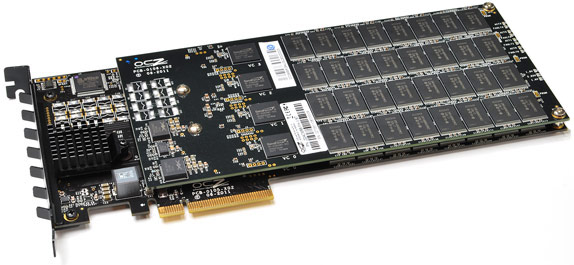OCZ Z-Drive R4 PCIe SSD Performance Preview
The OCZ Z-Drive R4
As we noted previously, the Z-Drive R4 is based on the very same chip-level technology that OCZ's RevoDrive 3 series employs. Though the RevoDrive 3's that we've looked at thus far are based on Micron NAND Flash, the Z-Drive R4 is built upon Intel 25nm chips. These chips specifically are 16GB density (128Gbits X 8). There are a total of 128 chips on the two PCBs of the Z-Drive R4 that we tested, for a total of 1.6TB of useable capacity, with an actual total of 2TB of NAND, with that spare capacity over-provisioned for maintenance and wear-leveling algorithms.

Full Length PCI Express PCB, X8 Gen 2 Edge Connector and a Prodigious Amount of Flash
Beyond fast, low power Intel Flash, what really drives the Z-Drive R4 is OCZ's SuperScale processor (the chip sitting beneath the small black heatsink). We won't delve too much into this device since we covered it in detail in our RevoDrive 3 X2 review here. Suffice it to say that the SuperScale Storage Accelerator acts as a Traffic Cop and load balancer of sorts channeling requests to the eight SandForce SF-2200 chips on the top and base PCBs. OCZ's proprietary VCA 2.0 (Virtuatlized Controller Architecture) supports both SandForce's garbage collection algorithms as well as TRIM and SMART monitoring functions. However, since VCA uses the SCSI protocol and the Windows StorPort architecture doesn't support TRIM or SCSI UNMAP, TRIM commands aren't generated by Windows to the drive. OCZ is working with Microsoft on this and hopes to have TRIM enabled "as soon as possible."


Power and Cooling:
Beyond Intel's Flash, the SF-2200 controllers, the SuperScale processor and a few power regulation circuits, there is a small Lattice PLD (Programmable Logic Device) that functions as a power monitor and sequencer for the Z-Drive R4. With the complexity of these PCBs, power control and timing has to be precise.
Speaking of which, this leads us to something that closely correlates to power -- heat. Though OCZ states max power consumption for the Z-Drive R4 is 26 Watts, it's our humble opinion that the cooling solution for their SuperScale Storage Accelerator isn't quite as robust as we would like to see. We had detailed dialog with OCZ on this topic and their specified 100 LFM (Linear Feet Per Minute) airflow requirement for the Z-Drive R4. Though we didn't measure airflow across the board, in our test system it required direct external cool airflow over the board to keep it stable. Standing at ambient room temperature, on an open air test bench, the board was not stable either. In fact, under the strain of our IOMeter tests, we had to dial cooling fans up high to provide adequate cooling.
We've also noted the same sensitivity to heat with the OCZ RevoDrive 3, though it's not as particular about airflow as the Z-Drive R4. However, if you sandwich the RevoDrive 3 in between two high-end graphics cards in SLI or CrossFire (a common setup for high end gaming or workstation systems), you better have a side intake fan pulling cool air in over the board.
However, we should underscore that the Z-Drive R4 is targeted for high-end workstations, but even more-so for datacenter applications with server platforms and high airflow chassis. In this application and usage model, the Z-Drive should get adequate airflow and remain stable. Regardless, we would have liked to see a more robust cooling solution on the product. In fact, OCZ has noted that their Engineering team is already working on a new cooling solution.
Alright then, benchmarks anyone?








